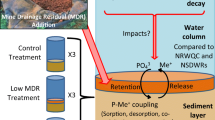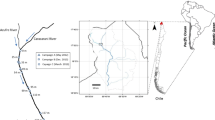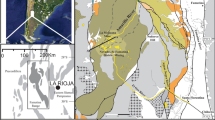Abstract
Acid mine drainage from open-cast coal mining has had detrimental effects on water quality and ecology in Herbert Stream, a low volume drainage on New Zealand’s Stockton Plateau, due apparently to the low pH (3.19–3.39) and elevated Al (dissolved Al = 8.1–11.4 mg/L). The long-term management liability, difficulty of diverting flow to existing treatment facilities, lack of space, and ready access to a large volume of circumneutral water (the Mt Frederick (MF) Quarry Lake) made dilution of Herbert Stream a potentially attractive management option. Dilution experiments showed that to achieve a pH > 4.5 or a dissolved Al concentration of <1.0 mg/L, mixtures comprising 73 or 90 % by volume of MF water, respectively, are required. To achieve Al3+ <0.42 mg/L, a previously determined ecological threshold concentration above which macroinvertebrate richness is significantly reduced, a dilution of >85 % MF water is required. However, geochemical speciation modelling indicated that at about this dilution, small changes in dilution result in large changes in the proportion of dissolved Al present as Al+3. In addition, while the proportion of Al3+ decreases significantly once the pH is sufficiently high to support the formation of Al hydroxide complexes (at >62 % MF water), precipitation of Al hydroxide and hydroxy-sulphate mineral phases also occurs at these dilutions. These precipitates and chemical species have established toxic effects. Negative ecological impacts across a range of dilutions, as well the difficulties of controlling dilution to the fine degree required within naturally variable streamflows, means that the use of simple dilution to manage Al toxicity in Herbert Stream is unlikely to be effective.
Zusammenfassung
Die saure Wasserhaltung des Kohletagebergbaus hat nachteilige Auswirkungen auf die Wasserqualität und Ökologie des Herbert Streams. Der geringe Abfluss auf Neuseelands Stockton Plateau hat offenbar Einfluss auf die niedrigen pH-Werte (3,19 bis 3,39) und erhöhten Al-Konzentrationen (gelöstes Al = 8,1 bis 11,4 mg/L) zur Folge hatten. Die langfristige Management-Haftung, Schwierigkeiten beim Ablauf bestehender Behandlungsanlagen, Platzmangel und leichter Zugang zu einem großen Volumen von neutralem Wasser (die Mt Frederick (MF) Quarry Lake) zur Verdünnung stellten eine attraktive Management-Option unter Verwendung des Herbert Stream dar. Verdünnungsexperimente zeigten, dass ein pH-Wert > 4,5 oder eine Konzentration an gelöstem Al < 1,0 mg/L, mit Mischungen von 73 %-Vol. bzw. 90 %-Vol. Wasser MF erforderlich sind. Es ist eine Konzentration Al3 + < 0,42 mg/l notwendig um die ökologische Schwellenwertkonzentration, die zuvor bestimmt wurde, nicht zu überschreiten. Um diese Konzentration einzuhalten ist eine Verdünnung mit > 85 % MF Wasser erforderlich. Eine geochemischen Modellierung zeigte jedoch, dass es bei dieser Verdünnung zu großen Veränderungen im Anteil an gelöstem Al Gegenwart von Al + 3 kommt. Während der Anteil von Al3 + signifikant abnimmt, wenn der pH-Wert ausreichend hoch ist (Bildung von Al-Hydroxid-Komplexen bei > 62 % MF Wasser), kommt es zur Ausfällung von Al-Hydroxid und Hydroxysulfat Mineralphasen auch bei diesen Verdünnungen. Diese Niederschläge und chemischen Spezies haben eine toxische Wirkung. Negative ökologische Auswirkungen in einer Reihe von Verdünnungen, sowie die Schwierigkeiten bei der Feinsteuerung der Verdünnung in Bezug auf den variablen natürlichen Abfluss, bedeutet, dass die Verwendung von einfachen Verdünnung die Al-Toxizität im Herbert Steam zu steuern zu schwierig ist.
Resumen
El drenaje ácido proveniente de operación minera de carbón a cielo abierto ha tenido efectos negativos sobre la calidad del agua y la ecología en Herbert Stream, un drenaje de bajo volume en Stockton Plateau de Nueva Zelanda, debido aparentemente al bajo valor de pH (3,19–3,39) y la elevada concentración de Al (Al disuelto = 8,1–11,4 mg/L). La responsabilidad de gestión a largo plazo, la dificultad de desviar el flujo a instalaciones de tratamiento existentes, la falta de espacio, y el fácil acceso a un gran volumen de agua casi neutra (el lago Mt Frederick (MF)) hacen de la dilución utilizando este último, una opción atractiva. Los experimentos de dilución mostraron que para alcanzar un pH > 4,5 o una concentración de Al < 1,0 mg/L, se requieren mezclas conteniendo 73 % y 90 % en volumen de agua MF, respectivamente. Para alcanzar concentraciones de Al3 + < 0,42 mg/L, concentración límite arriba de la cual la riqueza de macroinvertebrados se reduce significativamente, se requiere una dilución de > 85 % en agua MF. Sin embargo, el modelado de la especiación geoquímica indica que alrededor de esta dilución, pequeños cambios en ésta resultaron en grandes cambios en la proporción de Al disuelto presente como Al + 3. Además, mientras la proporción de Al3 + decrece significativamente una vez que el pH es suficientemente alto para permitir la formación de hidroxo complejos de Al (a > 62 % en agua MF), la precipitación de hidróxido de Al y fases de hidroxos sulfatos también ocurre a esas diluciones. Estos precipitados y especies químicas tienen efectos tóxicos ya establecidos. Los impactos ecológicos negativos a través del rango de diluciones, tanto como las dificultades para controlar finamente las diluciones dentro de los cursos de agua de flujo naturalmente variable, implican baja probabilidad de que el uso de la dilución para manejar la toxicidad del Al en Herbert Stream sea efectiva.
摘要
由于PH值低(3.19 ~ 3.39)且铝浓度高(溶解态铝浓度8.1 ~ 11.4 mg/L),露天煤矿酸性矿山废水已对新西兰斯托克顿(Herbert)高原小径流赫伯特河(Herbert)的水质和生态产生严重影响。长期管理的责任要求、难以分流至现有水处理厂处理的现状、污水储存空间的缺乏、大量中性水(Mt Frederick (MF)采场湖水)的便利等条件使得稀释有望成为治理Herbert河水污染的潜在方案。但是,稀释实验表明:要使PH > 4.5或溶解态铝浓度 < 1 mg/L,至少需要分别混合73 %和90 % MF中性水;要使得AL3+<0.42 mg/L(已确定的使大型无脊椎动物丰富度明显减少的生态阈值浓度),需要稀释85 %以上的MF中性水。然而,地球化学形态模拟结果表明,微小的稀释变化可能导致溶解态AL3+比例较大波动。而且,一旦PH值高至有利于铝氢氧化络合物形成(MF中性水比例大于62 %时)并使AL3+比例大幅减少时,铝氢氧化物和羟基硫酸盐矿物亦将析出。这些沉淀物和化学物质都具有生物毒性。呈负面生态影响的稀释浓度范围很宽,河流自然流量变化范围内控制稀释存在困难,因此简单依赖于稀释实现Herbert河流污水铝毒性治理难以有效。





Similar content being viewed by others
References
ANZECC (2000) Australian and New Zealand Guidelines for Fresh and Marine Water Quality, vol 1, Australian and New Zealand Environment and Conservation Council and the Agriculture and Resource Management Council of Australia and New Zealand
Black A, Trumm D, Lindsay P (2005) Impacts of coal mining on water quality and metal mobilisation: case studies from the West Coast and Otago. In: Black A, Centeno JA, Harding JS, Trumm DA, Moore TA (eds) Metal contaminants in New Zealand. Resolutionz Press, Christchurch
Cloutier S, Gelineau M, Guay I (2007) Calculation and interpretation of effluent objectives for contaminants in aquatic environments. 2nd edn. Report for the Ministere du Development Durable, De L’Environnement et des Parcs, Quebec, Canada. www.mddelcc.gouv.qc.ca/eau/oer/Calcul_interpretation_OER-en.pdf
Cravotta CA III (2008) Dissolved metals and associated constituents in abandoned coal-mine discharges, Pennsylvania, USA. Part 1: constituent quantities and correlations. Appl Geochem 23:166–202
Gensemer RW, Playle RC (1999) The bioavailability and toxicity of aluminium in aquatic environments. Crit Rev Environ Sci Technol 29(4):315–450
Greig HS, Niyogi DK, Hogsden KL, Jellyman PG, Harding JS (2010) Heavy metals: confounding factors in the response of New Zealand fish assemblages to natural and anthropogenic acidity. Sci Total Environ 408:3240–3250
Harding JS, Boothroyd I (2004) Impacts of Mining. In: Harding J, Pearson C, Sorrell B, Mosley P (eds) Freshwaters of New Zealand. NZ Hydrological Soc and NZ Limnological Soc, Christchurch
Hughs J, Craw D, Peake B, Lindsay P, Weber P (2007) Environmental characterisation of coal mine waste rock in the field: an example from New Zealand. Environ Geol 52:1501–1509
Lindsay P, Kingsbury M, Pizey M (2003) Impact of mining on the lower Ngakawau river. In: Proceedings of the Australasian Institute of Mining and Metallurgy, New Zealand Branch. 36th annual conference, 3–5 September 2003, Greymouth, New Zealand, pp 115–128
Markich SJ, Brown PL (1999) Thermochemical data (logK) for environmentally-relevant elements H, Na, K, Ca, Mg, Fe, Mn, U, Al, Pb, Zn, Cu and Cd with model fulvic acid (aspartite, citrate, malonite, salicylate, tricarballyate). ANSTO/E735 ANSTO Environment Div, Menai, Australia
Nordstrom DK, Alpers CN (1999) Geochemistry of acid mine water. In: Plumlee GS, Logsden MJ (eds) The environmental geochemistry of mineral deposits. Rev Econ Geol 7A:133–154
Nordstrom DK, Ball JW (1986) The geochemical behaviour of aluminium in acidified surface waters. Sci 232(4746):54–56
Nordstrom DK, May HM (1996) Aqueous equilibrium data for mononuclear aluminium species. In: Sposito G (ed) The Environmental Chemistry of Aluminum, 2nd edn. CRC Press, Boca Raton, pp 39–80
Parent L, Twiss MR, Campbell PGC (1996) Influences of natural dissolved organic matter on the interaction of aluminium with microalga chlorella: a test of the free ion model of trace metal toxicity. Environ Sci Technol 30:1713–1720
Parkhurst DL, Appelo DL (1999) Users Guide to PHREEQC (Version 2): A computer program for speciation, batch reaction, one dimensional transport and inverse geochemical calculations. USGS WRI 99-4259. ftp://brrftp.cr.usgs.gov/pub/charlton/phreeqc/Phreeqc_2_1999_manual.pdf
PCE (Parlimentary Commissioner for the Environment) (2009) Stockton Revisited: The Mine and the Regulatory Minefield. http://www.pce.parliament.nz/assets/Uploads/Reports/pdf/Stockton_mine.pdf
Pokrovski GS, Schott J, Harrichoury JC, Sergeyev AS (1996) The stability of aluminum silicate complexes in acidic solutions from 25 to 150°C. Geochim Cosmochim Acta 60(14):2495–2501
Poleo ABS (1995) Aluminium polymerization- a mechanism of acute toxicity of aqueous aluminium to fish. Aquat Toxicol 31:347–356
Poleo ABS, Lydersen E, Rosseland BO, Kroglund F, Salbu B, Vogt RD, Kvellestad A (1994) Increased mortality of fish due to changing al-chemistry of mixing zones between limed streams and acidic tributaries. Water Air Soil Poll 75:339–351
Roy RL, Campbell PGC (1997) Decreased toxicity of Al to juvenile Atlantic salmon (Salmo salar) in acidic soft water containing natural organic matter: a test of the free—ion model. Environ Toxicol Chem 16(9):1962–1969
Sengupta M (1993) Environmental impacts of mining; monitoring; restoration and control. Lewis Publ, Boca Raton
Soucek DJ, Cherry DS, Zipper CE (2003) Impacts of mine drainage and other nonpoint source pollutants on aquatic biota in the Upper Powell river system, Virginia. Hum Ecol Risk Assess 9(4):1059–1073
Trumm D, Watt M, Pope J, Lindsay P (2008) Using pilot trials to test geochemical treatment of acid mine drainage on Stockton Plateau. NZ J Geol Geophys 51:175–186. doi:10.1080/00288300809509858
Waters AS (2011) Aluminium in AMD Streams on the Stockton Plateau; Is Dilution a Management Solution? Unpubl MS thesis, Lincoln Univ, NZ
Waters AS, Webster-Brown J (2013) Assessing aluminium toxicity in streams affected by acid mine drainage. Water Sci Technol 67(8):1764–1772
Webster-Brown J (2005) A review of trace metal transport and attenuation in surface waters. In: Moore TA, Black A, Centeno JA, Harding JS, Trumm DA (eds) Metal contaminants in New Zealand. Resolutionz Press, Christchurch
Young RN, Mulligan CN, Fukue M (2014) Sustainable practises in geochemical engineering, 2nd edn. CRC Press, Taylor and Francis Group, Boca Raton
Acknowledgments
This research was supported financially and logistically by Solid Energy New Zealand Ltd, and in particular, Dr. Phil Lindsay, Dr. Paul Weber, and Aiden Bonisch.
Author information
Authors and Affiliations
Corresponding author
Rights and permissions
About this article
Cite this article
Waters, A.S., Webster-Brown, J.G. Is Dilution a Solution to Aluminium Toxicity in an Acid Mine Drainage Affected Stream on the Stockton Plateau, New Zealand?. Mine Water Environ 35, 235–242 (2016). https://doi.org/10.1007/s10230-016-0387-3
Received:
Accepted:
Published:
Issue Date:
DOI: https://doi.org/10.1007/s10230-016-0387-3




